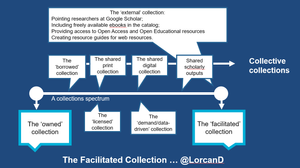Readers of this blog – or of the RLG Partnership work agenda – will be familiar with the phrase collective collection. We use it to refer to the intensification of systemwide interest in the management of collections, whether the system is at consortial, state, national or some other level. Consortial discovery to delivery systems, mass digitization initiatives, preservation of print and digital, off-site storage: many current discussions involve this systemwide perspective.
In simple terms, I think we can see a natural progression from shared discovery, to better resource sharing logistics, to collective collection development and management. The last has always been an interest, variably realized, but current pressures and capacities bring it back into focus in different ways. This progression is characterized by deeper resource sharing, greater mutual dependency and more extensive shared infrastructure.
Now, over the years, there have been some suggestions about updating Ranganathan’s laws [Ranganathan’s 5 laws of library science, Wikipedia]. These have not been very convincing. Once some adjustment is made for gender and format, I think that the laws actually continue to capture very well some fundamental challenges about what we do. And one of the interesting things to me is that the laws resonate even more strongly as we do more things at a collective level. In fact, conformance to the laws in many cases suggests moving in this direction. And this is in line with his fifth law: the library is a growing organism. In this case, we need to think about what effective service means in a network environment where service models and user behaviors and expectations continue to co-evolve.
Here is one example, among several I could advance: when writing about the long tail and libraries a while ago, Ranganathan naturally came to mind:
Discussions of the long tail that I have seen or heard in the library community strike me as somewhat partial. Much of that discussion is about how libraries contain deep and rich collections, and about how their system-wide aggregation represents a very long tail of scholarly and cultural materials (a system may be at the level of a consortium, or a state, or a country). However, I am not sure that we have absorbed the real relevance of the long tail argument, which is about how well supply and demand are matched in a network environment. It is not enough for materials to be present within the system: they have to be readily accessible (‘every reader his or her book’, in Ranganathan’s terms), potentially interested readers have to be aware of them (‘every book its reader’), and the system for matching supply and demand has to be efficient (‘save the time of the user’) [Libraries and the Long Tail: Some Thoughts about Libraries in a Network Age]
Incidentally, I left the above paragraph as a comment on Bob Molyneux’s nice post of a while ago about the user benefits of the collective Pines approach, as he too returned to Ranganathan in his discussion of how Pines makes the participants’ ‘collective collection’ available in one ‘big resource rich library’.
Related entries:



